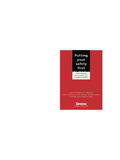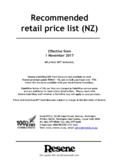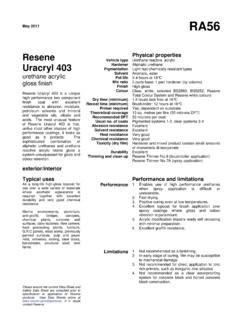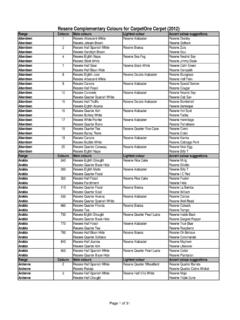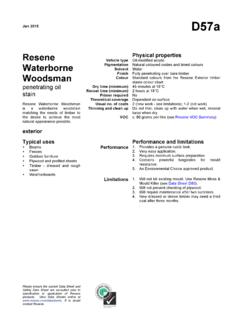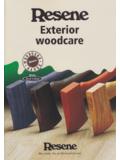Transcription of THE STORY OF NEW ZEALAND’S OWN PAINT …
1 THE STORY OF NEW zealand S OWN PAINT COMPANYAn illustration from an early advertisement for Resene waterborne was started in 1946 by an Eastbourne builder, Ted Nightingale, who needed an alkali resistant PAINT to cover his concrete buildings. There was nothing available at the time, so in typical kiwi style he developed his own - in a cement mixer in his garage! In response to demand from other builders, Ted commenced producing his PAINT on a commercial basis under the brand name was a cement based PAINT required by builders because there were really no paints on the market at that stage that were suitable for use over concrete.
2 Waterborne paints were not available until years later. As well as Stipplecote, Ted manufactured a range of admixtures, such as No Bond and Curecrete, which are still around today. The initial garage production facility was superceded by the establishment of Resene s first factory in an old stable in Tinakori Road, Wellington later that 1951, Ted Nightingale launched the first waterborne PAINT in New zealand under the brand name Resene - a name derived from the main ingredient of PAINT - resin.
3 This launch was followed in 1952 by company registration under the name Stipplecote Products Ltd and a move to a new larger factory in Kaiwharawhara, Wellington. A period of innovation was to paints had a very slow start. The marketplace was cautious with the new technology and had difficulty understanding that a waterborne PAINT would not wash off the walls with water. Customers initially remained loyal to lead and solventborne paints. It was only after a massive sales effort that waterborne PAINT sales really took off.
4 Demonstrations were run in shop windows showing boards being painted with waterborne paints and then the brushes being rinsed off in water. People standing in the street could not believe that the PAINT wouldn t just wash off the market eventually responded to the new PAINT technology and Resene s perseverance paid off with a period of rapid expansion during the late 1950s and early 1960s. As the emphasis shifted away from cement based paints towards waterborne paints, the company name was changed to Resene Paints Ltd in 1977.
5 Although the company had added a line of solventborne paints to the range in the late 1950s and early 1960s, waterborne paints remained its primary this time, the directors realised Resene had gone as far as it could with its limited manufacturing unit and selling laid the foundation for several key decisions that inhindsight proved pivotal. The first decision was to upgrade the manufacturing facilities to provide increased factory space.
6 Resene shifted premises from its older site in Kaiwharawhara to Gough Street in Seaview, Lower Hutt, where it remained for 25 years before shifting to its current location in Naenae, Lower Hutt in 1992. By relocating to the Seaview site, Resene became situated in an industrial area, which later provided for further expansion with a second manufacturing unit a few blocks second and probably most crucial decision in Resene company history was to completely overhaul the company s marketing.
7 In a huge gamble, Resene decided to risk alienating the industry s traditional sales outlets by sidestepping them in favour of using its own staff to sell directly to the 1970, Resene employed a sales manager and set about opening branches throughout New zealand . Initially each branch consisted of a warehouse as a base and a sales representative who drove around making calls on tradespeople. At about the same time the practice of leasing motor vehicles came into being and this allowed Resene to set up a fleet of vehicles without a huge capital initially focused on the professional market in Wellington and then rolled this strategy out to focus on towns like those in the Hawkes Bay - areas where the big companies were less focused.
8 Only once Resene had established itself in most smaller areas, did Resene increase its focus on between calls to tradespeople, the Resene sales representatives called on the architectural profession, Government Departments and local bodies. As a result of favourable dealings, many began to specify Resene paints on 1972, Tony Nightingale, Ted s son, took over the operation of the : An early advertisement for Resene Stipplecote, screen-printed on : A series of early advertisements showing the benefits of innovative Resene waterborne NZ OWNED1975 saw the launch of the first of a national chain of retail stores.
9 The move into retail occurred almost by accident. Tony bought a wallpaper company that happened to own a store in Marion Street, Wellington. It was at this site that the first store, originally called the Marion Street PAINT shop, was established. Following overwhelming success with the opening of this store, the ColorShop concept was conceived and duplicated in other regions. Soon there were ColorShops in Auckland, Hawkes Bay, Dunedin, Hamilton and this foray into retail, the mainstay of Resene s business has continued to be specifiers and professional painters who demand a high quality PAINT that is easy to apply, a wide range of colours and a high level of service and problem solving ability from the PAINT also built itself a reputation as the colour leader,with a number of firsts in this area.
10 In 1969 Resene set up a new system of colour, the British Standard Specification colour range (BS2660 range), which provided a range of strong colours at a time when New Zealanders were used to pastel colours. The stronger BS4800 range followed in 1973. The launch of the BS5252 colour range in 1976 was a world first. Resene pioneered the development of coloured PAINT bases, where previously only white was used. Resene was also the first company to offer a full range of testpots in New zealand in 1981.
